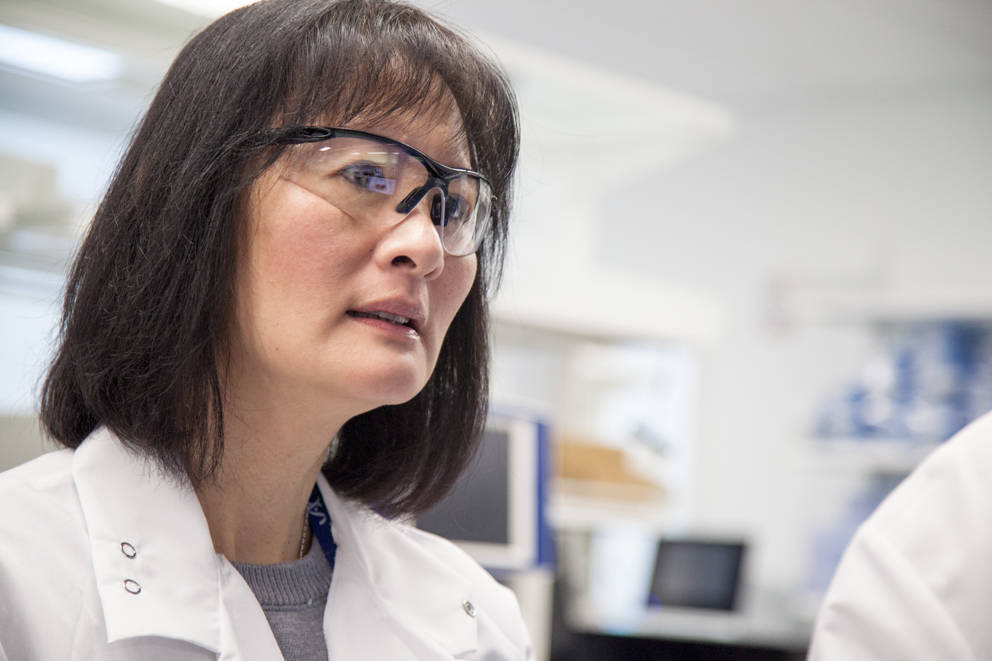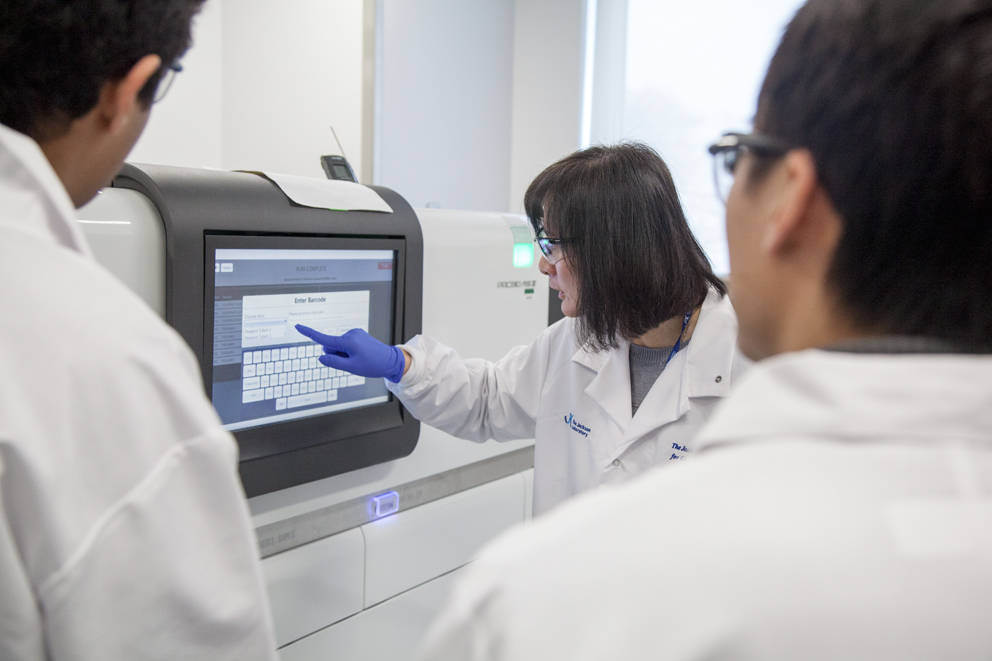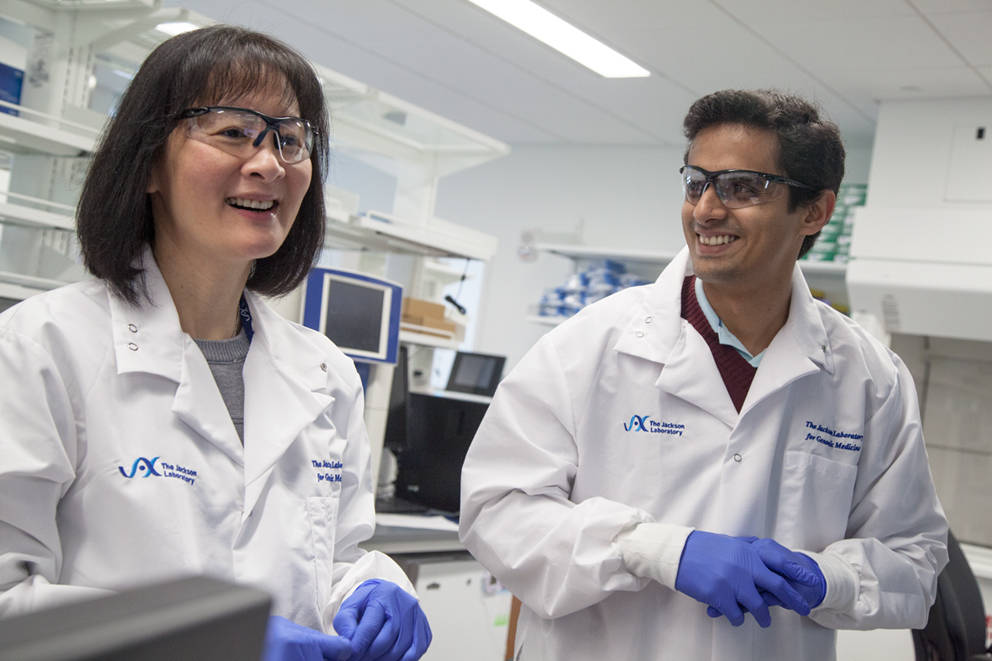
Chia-Lin Wei, Ph.D., is an international leader in genomics and sequencing with deep experience at government and industry labs. She recently joined The Jackson Laboratory as director of genome technologies, working from The Jackson Laboratory for Genomic Medicine in Farmington, Conn. Wei is responsible for developing genomic and sequencing services and providing them to scientists throughout JAX and to external researchers. Here she shares her vision and plans for supporting the Laboratory’s scientific research with genome technologies.
JAX’s mission is to discover precise genomic solutions to disease. How do genome technologies enable this work?
Genome technologies enable us to detect and characterize genetic inheritance, disease susceptibility, and responses to environmental influences and potential treatment regimes. These technologies, when applied effectively to examine variations in genetic makeup, RNA expression and epigenetic modifications at population scale and in high resolution, provide the basis for discovering marker genes, pathways and mechanisms of human diseases and the knowledge base for precision medicine.
What does your group at the Jackson Laboratory do?
The Genome Technologies group is the innovation hub and operation entity for cutting-edge genomic, transcriptomic and epigenomic technology development at The Jackson Laboratory. We are positioned to provide biologists with innovative genome technologies, robust processing and high-throughput assays to interrogate DNA, RNA, chromatin and their interaction networks with precision and efficiency.
On the technology front, we focus on developing new approaches as well as improving complementary existing technology platforms to facilitate integrative analyses and apply them to clinical or patient samples. Examples include the ability to interrogate gene expression and chromatin modification in samples or to examine non-coding RNA regulation and structural variations in the disease process.
On the operation front, we are working to build optimal infrastructure and streamlined processes so the technologies are run efficiently to generate high-quality data. These include standard operational protocols, implementation of automation, simplified data processing and development of standard quality-measurement metrics.

How do bioscience institutions like JAX manage the rapid evolution of genome technology to ensure that scientists are working with the right tools to advance their research?
The dynamic and rapid transition of genome technologies has been the key driving force for the advancement of genome biology and its biomedical applications. How an institute can make intelligent and timely moves to take advantage of these technological developments and advance scientific discovery, while also avoiding investments in the wrong platform and technology, is critical for the success of the scientific programs.
I believe success depends on experienced and knowledgeable leaders who can recognize and distinguish the high-level direction of the technology development, and on technical staff with innovative minds to invent and execute an array of disruptive methodologies. JAX will need to build up its advanced analytical capabilities and molecular biology skills by investing in human capital and proper equipment; establishing alliances with groups of known innovation capabilities such as Broad Technology Labs; and creating a collaborative environment for biologists and technologists to work together.
Who or what is driving the need for innovation in genome technologies?
Biological challenges and opportunities are the driving forces for technology innovation. It is well recognized that many of the great scientific discoveries and accomplishments would not have been possible without major technology breakthroughs.
For example, sequencing technology was the key enabling force for decoding the DNA sequence of the human genome. And our knowledge of transcription regulation could not be so advanced if it were not for the development of ChIP-seq technology, a method of analyzing protein interactions with DNA. Therefore, the unmet need to decipher genome function and to understand disease propensity at population scale and in high resolution will drive the next wave of genomic technology innovation.
What are the most important new genome technologies for advancing JAX’s work, and why?
In my view, there are several areas of technology development that will immediately impact and propel JAX science, including these two:
- The ability to interrogate multi-scale genome variations that are relevant in human diseases at large scale and in a cost-effective manner. Methods such as whole-genome sequencing have been widely used with limitations. We are trying to develop a more comprehensive method to examine genome variations in disease populations. This approach, if successfully applied to disease samples, will help JAX scientists uncover new pathways and mechanisms relevant to diagnosis or therapeutic applications.
- The ability to examine multi-level epigenetic and gene-regulation changes simultaneously in precious in vivo tissues or cells. This ability will enable scientists to study gene regulatory pathways in response to environmental exposure and provide valuable knowledge of how epigenetic mechanisms impact disease and development.
Is JAX developing any new genome technologies? If so, what are they, and how might they advance the Laboratory’s genomic research?
Yes. We are looking to establish the next-generation, single-molecule, pore-based sequencing platform. This platform will strengthen our ability to analyze genome structure and its modification from a new angle. We are also developing an approach to performing different sequencing analyses at nano-scale through a multiplex bar-coding approach. This method will enable genomic analysis of very small samples, allowing us to profile changes in different cell populations. We are also working on a comprehensive genome-variation analysis that will provide all levels of variants in a single experiment including single nucleotide polymorphisms (SNP), copy number variations (CNV), structural variations, etc.

How many staff are in your group, and what is their typical training and expertise?
Currently, we have 17 staff. Two-thirds are in Bar Harbor, Maine, and one-third are in Farmington, Conn. They have a wide range of research backgrounds and expertise.
Most of the staff members in Bar Harbor have solid experience in mouse biology and genetics. They also have in-depth knowledge in processing mouse tissue samples and are expert in developing assays to determine mouse genotyping and strain variations. They also manage a highly productive capillary sequencing platform that supports the vast majority of clone-based sequencing analysis.
The staff members in Farmington are relatively new and came from a fairly diverse background of genomic research, including immunology, molecular biology, RNA biology and sequencing technology. Some have the ability to process and analyze high-throughput sequencing data.
How does your group work with the research faculty to help meet their genome-technology needs?
We build partnerships. One of the important capabilities I hope to bring with my expertise is our ability to provide customized experimental design and approaches specific to unique biological challenges and opportunities. Because genome technologies are highly dynamic and rapidly evolving, often there is no “one size fits all,” particularly in a highly sophisticated field such as medical genomics.
We work with faculty members side by side to understand their questions, hypotheses and research topics, and to define the best strategies and analysis tools. Therefore, it’s very important for our group not only to excel in technology innovation but also in matching technical development with the right scientific questions. Clearly, the challenge on our end is how we can, in the process of new technology development, also deliver high-quality experimental data under a “cost recovery” operational model that is used by most of the service core at JAX. As most of technology development is an iterative process with a higher failure rate, mechanisms like technology-innovation funding opportunities are in place to support this endeavor. We will gain more experience in this area during the next six to 12 months.